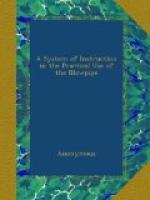Formula. ZnS.
Behavior
(1) in glass-bulb. Decrepitates strongly.
(2) in open tube. Evolves SO
and becomes white or yellow if
containing
iron.
(3) on charcoal. V. In the
reducing flame incrusts the charcoal
with
ZnO; also with CdO, if that metal be
present.
(4) in forceps. —
(5) in borax. The roasted
mineral gives a zinc reaction, and
sometimes
a slight iron reaction.
(6) in mic. salt. As in borax.
(7) with carb. soda. As alone on
charcoal. Moreover colors the flame
blue.
The fused alkali gives a S reaction on
silver.
(8) Special reactions. —
* * * * *
Mineral. Red oxide of zinc
Formula. [.Zn].
Behavior
(1) in glass-bulb. —
(2) in open tube. —
(3) on charcoal. In the reducing
flame forms a thin incrustation
of
oxide of zinc on the charcoal.
(4) in forceps. V.
(5) in borax. Generally
gives a manganese and slight iron
reaction
in addition to that of zinc.
(6) in mic. salt. As in borax.
(7) with carb. soda. On charcoal, forms a thick incrustation of ZnO.
(8) Special reactions. With carbonate
of soda and nitre on platinum
foil
gives manganese reaction.
* * * * *
Mineral. Electric calamine
Formula. 2[.Zn]^{3}[...Si] + 3[.H]
Behavior
(1) in glass-bulb. Gives off water and becomes white and opaque.
(2) in open tube. —
(3) on charcoal. —
(4) in forceps. V.
(5) in borax. Dissolves
to a clear glass, which cannot be
rendered
opaque by the intermittent flame.
(6) in mic. salt. Dissolves
to a clear glass, which becomes opaque
on
cooling. Silica remains insoluble.
(7) with carb. soda. With carbonate
of soda alone is infusible. With
2
parts of alkali and 1 of borax fuses to a
glass
and sets free [.Zn], which incrusts the
charcoal.
(8) Special reactions. —
* * * * *
Mineral. Calamine
Formula. [.Zn][..C].
Behavior
(1) in glass-bulb. Gives off CO^{2} and becomes opaque.




